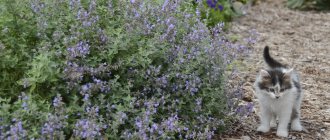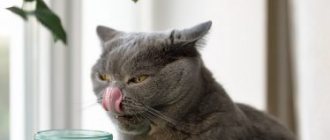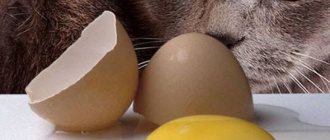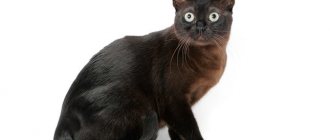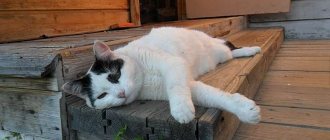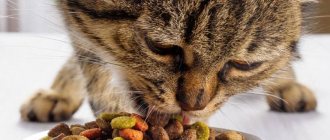Probably everyone who has cats has heard more than once that there are herbs that they feel addicted to. For example, valerian. However, this is not the only plant whose fragrance has a funny “narcotic effect” on cats.
There is another perennial herbaceous plant - it is called catnip. Simply put, catnip. The original lemon scent of catnip attracts four-legged animals, although not as powerful as valerian. The effects of it do not last long, and not everyone reacts to its smell.
As it turns out, cats love mint. Many people cultivate this plant in their gardens. And if you don’t have your own front garden, it doesn’t matter, you can try growing catnip for cats at home, in pots or flower boxes. Catnip is simple and unpretentious. It blooms with cute little lilac flowers. This grass is a honey plant, it contains a lot of nectar, so the bees do not ignore it.
Why do cats love mint? The leaves and inflorescences of the plant contain a lot of essential oil, which smells like lemon and this attracts the attention of cats. If you rub the leaves with your fingers, the smell becomes even stronger. Both fresh and dried herbs have a bright attractive aroma.
If you give a cat catnip, it will have a slight relaxation effect, and he may roll on the ground, crush the leaves of the plant, purr, shake his head, drool, jump as if experiencing a feeling of joy, or vice versa, lie on his back and spread his paws.
Other animals may have the opposite reaction; the smell of mint may arouse aggression in them, and they will behave as if during mating season. There are many videos on YouTube with cats about how the animals love to roll around in thickets of plants, chew twigs or rub against them under the influence of catnip: it’s so funny to see the reaction catnip produces on them! And it also happens that the cat ate mint and, on the contrary, became quiet and relaxed, lay down under a bush and seemed to be sleeping.
Description of the plant
Lemon catnip grows in Central, Eastern and Western Europe, East Asia, western Siberia and the Caucasus.
In appearance, the plant is almost no different from ordinary mint. But catnip contains nepetalactone, and peppermint contains menthol. It is for this reason that these plants have different smells. The aroma of catnip contains lemon notes.
The leaves of the plant are light green in the shape of a heart, sometimes they may contain splashes of white or pink. The flowers are small, collected in a brush. They can be white, pink or purple. Catnip stems are long. They spread along the ground and intertwine with each other, forming dense thickets. Today there are about 200 species of this plant.
Cats love to spend time in catnip thickets. As a rule, in such places you can see more than a dozen animals at once. Catnip exudes an aroma that has an effect on them similar to that of valerian. Animals seem to fall into euphoria. At the same time, they can behave very strangely.
How to collect miracle grass?
Only the above-ground part of this plant can be used as a medicinal product. The plant is collected taking into account the timing of its flowering and ripening. Typically, cat's paws begin to bloom in mid-May and continue until the end of July. The fruits of the plant appear in July–August.
And in order to benefit from the medicinal plant, it should be collected during the flowering period. At the same time, if it was not possible to collect in such a way that the plant’s cap remains intact, then you can collect and dry individual flowers. Quite often, pink immortelle is dried naturally in air. It should be taken into account that the dried stem, leaves and cap of cat's paws are stored and have the value of their medicinal properties for only 1 year.
For nature lovers: what is Scots pine?
The principle of influencing a cat
When an animal inhales the aroma of a plant, essential oils enter its respiratory tract. From there the signal goes to the hypothalamus of the brain. The cat experiences short-term hallucinations, and as a result, strange behavior. The animal begins to roll on the floor, purr, jump, lick, and play. This is similar to the behavior of a kitten.
The effect lasts 10-15 minutes, after which the cat calms down and may fall asleep. This continues for about half an hour. The reaction may then repeat. If a cat tastes catnip, the effect may be the opposite.
The plant affects animals in different ways. A lethargic cat can become playful. And if the animal is very active, it is likely that under the influence of catnip, it will become passive. This should not be a concern for owners. The animal has an intuition that tells it when to stop sniffing or chewing the plant.
Why cats like grass
Representatives of the cat family love this plant because its essential oils act on them like pheromones, causing pleasant hallucinations. After smelling it, the animals begin to purr, rub their entire bodies and roll around on the floor, and they can meow loudly.
The essential oil of the herb contains a specific substance called nepetalactone, which affects the brain centers of the animal. But the effect of this substance lasts no more than 15-20 minutes, then the animal becomes indifferent to the stimulus. The reaction to it may appear again after 3 hours.
What does a cat's paw cure?
The unique combination of the above-described active substances explains the properties that the plant has:
- stop heavy bleeding, including after childbirth;
- heal wounds;
- choleretic effect;
- analgesic and anti-inflammatory effects;
- fight malignant tumors;
- relieve spasms and dilate blood vessels;
- have a sedative and antitussive effect;
- also has a diuretic effect.
When used externally, in the form of a tile, it is used to soothe irritated skin. It can also be noted that freshly frozen plants have a healing effect on cutting wounds. In conclusion, we can refute the information sold that cat panties act as an aphrodisiac on cats. This belief was created by the fact that a cat's singing results in "cats frying on the ground", which is a manifestation of cats in cats. But this is unlikely because it also causes the same thing in cats.
In ornamental gardening
It can be said that a cat is most likely to respond to "feel good" pheromones released during catting and other lovemaking activities. However, singing induces cats and non-sexual behavior such as playing, chasing and hunting. Its arboreal, climbing stems can reach up to an impressive 30 meters.
Cat's paw helps fight cancer
How the plant is used
Some owners believe that catnip has a negative effect on the pet's nervous system. This is a misconception. On the contrary, using catnip will help get rid of many problems, incl. psychological. Catnip can be used in situations where:
- the pet has an aggressive character - just give him a little dried catnip.
- the cat is very playful and is capable of turning everything upside down in the house, the plant will have a calming effect on him;
- It is necessary to accustom the animal to the tray - you should put a little dry catnip under the container. The smell will attract the cat's attention, and the learning process will be faster and easier;
- the owner is going on a trip with the pet, or is planning a trip to the veterinary clinic - we recommend putting a few sprigs of catnip in the carrying bag, this will help relieve stress in the animal;
- the cat has recently arrived in the house and needs to get used to its new housing, it is recommended to place branches of the plant in the area of its sleeping place;
- the animal is passive and lethargic - a little catnip placed in toys will cheer it up;
- your pet has a stomach spasm - the bactericidal properties of catnip will help solve the problem;
- the animal refuses to eat - catnip will increase appetite;
- the cat sharpens its claws on the furniture and ignores the scratching post - you should carefully open the covering of the scratching post, place plant branches inside it and sew it up. The animal will smell the mint and leave the furniture alone. This is one of the most effective ways to train a dog to use a scratching post.
Catnip can be used both fresh and dried. When stored, the plant retains all its properties.
You can buy packaged dried grass in pet stores - the crushed powder is added to the cat's food or sprinkled on those places in the house to which the pet needs to be accustomed. They also sell crunchy catnip-infused pads and chew sticks designed to clean your pet's teeth.
To play with animals, use soap bubbles that contain catnip extract. The pet will actively react to flying bubbles with a tart lemon aroma.
For animals that are weakened after illness and when they refuse to eat, canned meat with nepetalactone added is suitable. This type of food will increase your appetite.
Chopped grass is added to various toys that are sewn from fabric (they can be of different shapes and colors).
Use in folk medicine
Cat's paws, which have a very wide spectrum of action, have found their use in almost all areas of medicine. Most often used as a hemostatic agent. All parts of the flower, containing tannins, phytosterol, resins, saponins, and vitamin K, have medicinal characteristics. Thanks to this, cat's paw is successfully used in the treatment of various diseases.
Its healing decoctions are used to treat tuberculosis, bloody vomiting, convulsions, and hypertension. The plant is used as a sedative, anti-inflammatory and choleretic agent.
Infusion of cat's paw flowers treats cholecystitis, liver diseases, diarrhea, and gallstones. To do this, brew 2 tablespoons of flowers and herbs together in a thermos with a glass of boiling water, leave for about half an hour, shaking occasionally. Pour the resulting product into a bowl, boil, cool and strain. Take 3 times a day, one tablespoon before meals. For a 10-day course, take a week break.
The benefits and harms of mint for cats
It can be argued that catnip is a corrector of animal behavior. For example, aggressive pets who consume the plant turn into affectionate and cute ones. In turn, lazy and calm cats turn into active and playful pets. In addition, the plant can affect cats in the following ways:
- after eating mint, it turns out that it has a bactericidal effect, relieving cramps in the animal’s stomach;
- according to veterinarians, catnip is considered an anti-stress drug that helps the animal calmly endure moving or other situations that cause stress in the cat;
- the grass is not a strong narcotic substance and therefore the animal does not get used to it with rare and controlled use of mint;
- if the animal does not want to eat, mint added to food in dried or fresh form causes appetite;
- the plant can be used as an anthelmintic.
After the popularization of catnip among pets, many companies began producing cat products infused with the plant's aroma. And some breeders independently made toys containing dried grass leaves. They also began to produce special drops that teach the cat to sharpen its claws in a certain place, which is sprayed with an essence with the aroma of catnip. This allows you to wean the animal from damaging upholstered furniture.
The advantage of the plant is that it can be easily grown in a flower pot on a windowsill that is constantly illuminated by sunlight. In this case, the plant does not need to be watered frequently, and the soil should contain a minimum amount of acid-containing substances. To prevent the cat from being tempted to eat the flower, after it ripens, the mint is picked, crushed and dried. The cat drug should be stored in a place inaccessible to the animal.
In addition to the fact that the plant is favored by cats, it is very popular with bees, who are attracted by the nectar of mint flowers. The plant is also used in the manufacture of vermouth, soap, perfume and other cosmetics. Plus, the plant has medicinal properties that help improve stomach function, soothe migraines and eliminate coughs.
Catnip does not harm the cat, if only for the reason that it will not enjoy the aroma of the plant incessantly - after 10-15 minutes of contact with the magical aroma, the cat temporarily loses interest in it.
The only exceptions to the rule are aggressive, extremely excitable individuals, on whom the action of catnip can have an adverse effect: the animal can attack other pets and the owner, mark the territory, that is, there is an adverse effect on the cat’s nervous system. By the way, there are about 15-20% of cats that do not perceive the scent of catnip and are not interested in it.
The plant will also not be in demand among kittens whose age has not reached puberty. In any case, the owner should not abuse catnip on his own, constantly adding it to the cat’s food or flavoring all objects belonging to the animal with the plant extract - bowls, bedding, toys, tray, and so on.
Eating catnip may be natural for animals
, since some types of parasites do not tolerate this plant. Alternatively, chopped catnip can be added to
in small quantities to wake up
in an animal. You just need to remember that in everything you need moderation, and in the case of catnip too. By the way,
This seasoning should not be offered to food, since catnip greens can cause increased blood flow and intestinal spasms.
Growing such an unpretentious plant is not difficult - it is perennial and does not require special care. If the animal owner does not have the opportunity to plant catnip in the garden, then this can be done even at home - on the windowsill in a pot. In pharmacies you can buy dried catnip leaves and flowers, as well as plant extract.
In addition to its benefits for cats, catnip is also attractive for people - in folk medicine (as a sedative, for diseases of the upper respiratory tract, headaches) and in cooking (as a spice, an additive to fish and meat dishes), as well as medicinal teas.
If we compare the effects of valerian and catnip, then the first plant, perhaps, has a greater arousal effect on the cat (especially if we are talking about an alcohol tincture). Outbreaks of an unprecedented surge of joy can negatively affect the animal’s psyche, which is why it is best to plant a plant in the garden and let the cat decide for itself whether to inhale the magical aroma for pleasure or not.
With the help of this plant you can influence the behavior of your pet in accordance with the situation. It is easy to calm the animal or, conversely, make it be more active, mobile and playful.
In addition to changes in mood, the owner notes the positive effect of the aromatic herb on the health of their pets. Catnip has antibacterial properties, due to which pathogenic bacteria die in the animal’s digestive tract.
After exposure to the active substance of mint, the cat’s body is cleared of helminths.
Often, cat owners use catnip to train their cat to use a litter box, scratching post, or bed.
This herb is not addictive in animals, but sometimes it can be harmful. You should not give mint to pregnant or lactating cats.
Indications for use
To treat many diseases at home, you can make medicinal raw materials using baskets, stems, leaves and flowers of immortelle. The product can also be purchased in pharmacies. The use of immortelle is indicated for the following diseases:
- gastritis and stomach ulcers;
- cholelithiasis;
- hepatitis;
- diarrhea;
- haemorrhoids;
- cholecystitis;
- endometriosis;
- uterine fibroids;
- hypertension;
- lung diseases;
- eczema and dermatitis;
- diathesis;
- furunculosis.
For the treatment of gynecological diseases, cat's paw is taken as a tincture: 1 tbsp. pour a spoonful of dry and fine herbs into ½ cup of hot water and leave to steep for half an hour. Then the resulting decoction is filtered and consumed on the 4th day of menstruation. The tincture must be used 3 times a day until the critical days are over.
To prepare a tincture with a choleretic effect, you will need 2 tbsp. l. dry ground plant, which is brewed with one glass of hot water and allowed to cool for an hour. Then the dried flower is poured into a saucepan and brought to a boil. Next, remove the broth from the heat and leave for another hour. The finished tincture is filtered and drunk 3 times a day, 1 tbsp. l. an hour before meals. The duration of treatment is 10 days.
To get rid of bleeding from hemorrhoids, lotions are often prescribed. Preparation is as follows: 2 tbsp. l. crushed cat's paws are poured into 250 ml of hot water. Leave the infusion to steep until it cools to room temperature. Then the broth is filtered and a pharmaceutical gauze swab is moistened in it, which is applied to the sore spots for 15-30 minutes. The course of treatment is 7 days.
Cat's paw grass is a low (about 30 cm) herbaceous plant with small flowers collected in small neat baskets.
Contraindications
Cats are naturally endowed with the ability to recognize which grass they can take and in what quantity. However, the owner is responsible for the pet. Therefore, you should not rely on the animal’s intuition if:
- the cat is pregnant;
- the pet reacts too violently to the action of catnip. In this case, excessive consumption of grass can deplete the animal's nervous system. A violent reaction should be understood as agitated behavior of the cat for more than half an hour with excessive physical activity.
In these cases, you should limit your pet's access to catnip. There are no other contraindications to taking catnip. But, if there are several cats in one house, and among them there is a male, it must be taken into account that under the influence of the plant he can become aggressive. Therefore, cats can only be given catnip separately from cats.
The use of the plant is contraindicated in the following cases:
- if the animal is pregnant, and eating mint can greatly overexcite or, conversely, calm the cat;
- The use of catnip is not recommended for pets who react too violently to the components included in the plant, because due to an uncontrolled surge of emotions, depletion of the cat’s nervous system can occur.
In general, it is natural for cats to choose the right plant and they understand exactly which grass they can eat and which they cannot. If a person decides to have a pet, he will have to take care not only of the physical, but also of the mental state of the animal. Therefore, it is important to constantly monitor the cat and, if deviations in behavior are detected, decide whether to give the animal catnip or not.
Why cats don't react to mint
Catnip does not affect all animals; some of them do not have the gene in their bodies that makes them susceptible to the herb.
Kittens up to 6 months of age do not react to this plant either: they simply do not need grass, they are quite playful without it.
An adult animal may not react to catnip if there is severe stress. To improve the emotional state of your pet, you should treat your pet with mint in advance.
In some cases, the plant has no effect on animals due to its low essential oil content.
Why doesn't my cat react to catnip?
The effects of catnip do not apply to all cats. A specific gene in the animal’s body, which may or may not be present, is responsible for susceptibility to the plant. This is typical for every third individual.
Kittens that have not reached sexual maturity also do not react to catnip. But they don't need it. Kittens are already very playful. Before 6 months there is no point in giving them catnip.
An animal may not respond to catnip under severe stress. Therefore, if there is a situation ahead that can significantly affect the emotional state of the pet, it is recommended to treat it with catnip in advance so that it has time to relax.
The animal's immunity may also be explained by the low content of essential oil in the plant. Usually it contains up to 3%, but this figure may decrease if the plant does not have enough light.
When should you feed your cat this product?
The cat should be fed if it is not on ready-made food from a pet store.
You can add yolk to milk as early as the kitten’s 24th birthday for growth and good coat. A cat is a carnivorous animal that must eat mainly protein foods. But there is evidence that feeding exclusively with meat alone can lead to disruptions in the digestive system and even chronic diseases of the liver and kidneys. Therefore, it is very important that the foods that provide the body with proteins are varied. Some owners fear that feeding eggs to cats is harmful. However, most veterinarians and breeders are of the opinion that it is not only possible, but even necessary to introduce this product into the diet. After all, by giving an egg to his pet, the owner provides her with another source of high-quality protein, in addition to meat and fish. The proteins contained in the egg are almost 100% digestible and will not harm a healthy cat.
In addition, eggs are rich in vitamins and minerals. They contain phosphorus, potassium, calcium, sodium, magnesium and iron, which ensures healthy bones and joints, as well as stability of the nervous system, elasticity of blood vessels, balance of hormones, acids and alkalis, and much more. The vitamins contained in one egg can meet 1/3 of the daily needs of an adult cat.
How to grow catnip in a pot - step by step instructions
In nature, catnip can be found in forests, bushes, meadows, fields, vegetable gardens, along river banks and near roads. To be able to pamper your pet at home, you can grow the plant indoors in a pot. Please note that catnip loves warmth, moisture and light. A lack of these components can negatively affect the performance of the plant.
Catnip can be grown from seeds, which are sold at any pet store. But it’s better to take a cutting or a rooted shoot, which can be found right on the street. The cutting should be placed in a glass of water, where it should remain until roots appear. When choosing a pot, you need to give preference to a medium-sized container.
The plant is recommended to be planted in early autumn. Then you should follow the following sequence of actions:
- Pour drainage into the pot.
- Fill the container halfway with soil, which should be pre-moistened.
- Plant seeds or seedlings in the ground.
- Cover the pot with film, creating greenhouse conditions.
- Place the container in a lighted place.
After two weeks, sprouts should appear. When the first leaves form, the plant should be fed. It is necessary to select the strongest shoots and clear space for their growth. The stems need to be secured with wire. About 2.5 months after planting, with proper care, catnip should bloom.
Catnip should be re-fertilized in February, when daylight hours increase and the plant begins to actively grow. It is necessary to ensure that the catnip has enough light. Otherwise, the amount of essential oils in the leaves will decrease.
In summer, catnip should not be kept in direct sunlight to prevent the soil from drying out. The plant loves moisture, so there should always be water in the pan.
How to give catnip to your pet?
It is not recommended to give catnip to pregnant cats, because the use of this herb can adversely affect the development of kittens and their gestation. You should not allow your cat to become stressed during pregnancy. But if an animal is walking on the street, finds mint and sniffs it, then there is no need to ban it. The animal intuitively feels its needs.
Pet supply stores offer a wide range of catnip in different forms. You can buy the grass, crushed into powder, which is used to rub the toy or floor, or you can immediately purchase a ready-made toy. In addition, sprays and essences of catnip are sold, which are sprayed in the right places or on the right objects.
You can have fresh catnip leaves all year round. The plant grows well in a flowerpot on a well-lit windowsill. At the same time, to plant grass, you will need a wide flowerpot or any other convenient container with normal soil composition. However, it is important to ensure that the four-legged pet does not reach the plant while it has time to grow.
Cat mint
Treatment of female diseases
Cat's feet is a plant used to treat female diseases, in particular, it is used for uterine, wound, pulmonary bleeding, hemoptysis, menstrual irregularities, leucorrhoea and hernia, postpartum complications. In this case, douching (2 times a day) and tampons soaked in a composition obtained by diluting 200 ml of decoction in a liter of boiled water are effective.
To stop bleeding, the following composition is used: 1 tablespoon of chopped herb is poured with boiling water (100 ml), infused for 30 minutes. Strained. You should take a tablespoon of the mixture every hour and a half until the bleeding stops completely. For uterine bleeding, this product is used as tampons.
For gum inflammation and periodontal disease, this infusion is effective as a rinse.
It is recommended to wash your face with a decoction of cat's paws for jaundice; baths with such a healing agent are used to treat childhood eczema and diathesis. A decoction prepared from 8 grams of raw materials diluted with 200 grams of boiling water can be used as a diuretic (a tablespoon 3 times a day). By the way, the shelf life of the decoctions is no more than 2 days in the refrigerator. When used externally, the concentration of the decoction is higher. For 200 ml of boiling water, take 16 grams of raw materials.
The herb-dried cat's paws helps in the resorption of hemorrhoidal cones, treats duodenal and stomach ulcers.
A decoction of cat's paw in the form of a lotion relieves hemorrhoids. The herb helps improve vision and is used in the treatment of glaucoma and cataracts. To do this, you need to sew a small bag, put the flowers of a magical plant in it, soak it in boiling water and apply it warm to your eyes before going to bed.
“Breast grass” is the name given to cat’s paw. The photo conveys all the charm of this modest plant, which is so called for its effective help in the treatment of colds. The herb is brewed and drunk as tea.
Catnip Products
Pet stores offer a wide range of catnip in different forms. First of all, these are bags with dried leaves of the plant. The grass can be used at your discretion: put in toys, scratching posts, under the tray, in the cat's house, etc.
- Catnip “Alpine Meadows”
Check the price in the store
- Treat for cats Beaphar “Catnip Bits”
- quick sedative effect;
antibactericidal and antihistamine properties;
- vitamins and minerals in the pads.
- Toy for cats GiGwi “Mouse”
Toys stuffed with catnip leaves will cheer up your pet.
- increasing physical activity of lazy pets;
training the hunting instinct on a realistic mouse model;
- Replacement bags of catnip to renew the effect.
- Scratching post “Clawfoot”
Catnip scratching posts contain fragrant leaves of the plant inside, which will attract the attention of the animal and keep the furniture intact.
Check the price in the store
- Soap bubbles with catnip Soap bubbles with catnip will cheer up your pet.
He will play and catch colorful balls. Check the price in the store
Dreamies Mix Catnip Pads are a good cat treat with vitamins and minerals included. Check the price in the store
Check the price in the store
Check the price in the store
Features and photos, plants
If desired, catnip can be grown at home; seeds are sold at pet stores. Cuttings take root well, which are separated from an adult bush and placed in a container with water. The rooted plant is planted in a medium-sized pot, which is placed in a well-lit place.
With a lack of light in the grass, the amount of essential oil decreases. But direct sunlight should be avoided so that the soil in the pot does not dry out. The plant is moisture-loving; there should always be water in the pan. Mint should be fed at least 2 times per season. With proper care, it should bloom in 3 months.
The plant has a strong aroma with lemon notes. In natural conditions, the grass is rarely found at great height and has a tetrahedral stem. At the same time, catnip, the photo of which is presented in the article, does not grow upward, but spreads parallel to the ground. At the point where the plant comes into contact with the soil, a root is formed, and the catnip quickly spreads across the surface of the soil, forming an original living carpet.
The plant has opposite foliage and funnel-shaped flowers, with lower petals shaped like an elongated lip. The inflorescences are placed in special whorl boxes. The lower petals are painted with dark dots. If the stem is broken, a pungent aroma immediately spreads due to the high concentration of essential oil.
In forests, gardens, various wastelands and hills you can easily come across this unusual plant. Today there are more than 200 species of catnip. Catnip can reach a meter in height. The grass stem is usually uneven, and the flowers resemble miniature bouquets gathered together. The plant has white, pinkish flowers with brown spots, as in the photo.
Cat mint
How to give eggs to a cat
Both chicken and quail eggs can cause food intolerances and allergic reactions.
Therefore, they should be introduced into the diet gradually. For an adult cat, 1-2 eggs per week is considered the norm. You can offer them to the animal by mixing them with meat, cottage cheese or vegetables. Remember: eggs can only be given to cats boiled, since eating this product raw can cause salmonellosis. In order not to endanger the animal and your entire family, eggs should be boiled for at least 4 minutes, this will ensure the destruction of pathogens.
The perennial herbaceous plant cat's paw is widely used both in medicine and in ornamental gardening, because it looks great in rock gardens and rockeries. It may seem like a rather inconspicuous plant, but it fits perfectly into a rocky landscape. In addition, the dioecious cat's paw has a very interesting property. The velvety heads of this plant actually resemble the soft paws of cats in shape and to the touch. The stems and leaves are also covered with fluff, which actually performs the most important function: it protects the surface from excessive evaporation of moisture.
A perennial herbaceous plant, cat's paw, is widely used in medicine and in ornamental gardening.
The Latin name of this plant is Antennaria. This is a low perennial that rarely grows above 25 cm. A creeping rhizome from which recumbent shoots extend, leaves collected in rosettes, and very modest flowers - all this could make the plant not very attractive. But, fortunately, as the grass grows, it forms beautiful, rather dense, silvery carpet thickets. It is because of this that it is used to decorate alpine slides, in rocky and heather gardens. You just need to remember that this grass prefers well-lit places and loves sandy soil.
The flowers of this plant are collected in several baskets. The apical basket is the largest of them, its diameter is about 6 mm, so it is a kind of cap. Since the plant is dioecious, the baskets are male and female. They vary in both color and shape. For example, male flowers have white petals, while female flowers have pink petals. Interestingly, the baskets with female flowers look less like a hat and more like a bowl, since they are distinguished by their oblong shape. Men's baskets are shaped like a ball.
The plant blooms from mid-May to the end of July, but the fruits ripen much later, at least in July, and sometimes in August.
The Latin name for this plant is Antennaria.
Cat's foot grass is a plant that has many popular names. For example, nechuevik, since in the old days it was identified with the mythical plant nechuevik, which supposedly helped blind people find treasures. Some call it chest herb and, indeed, antennaria helps to cure colds faster. There is also such an option as white immortelle - this is mainly due to the flowers in the man's basket. And also because even when dried, the plant retains its appearance and most of its properties. However, from time to time in everyday life you can hear such a name as cat eggs - all because of the same soft fluff.
It is interesting that the fruits of this plant - oblong achenes - are covered with fluff, and on top of them there is a cap consisting of jagged hairs. Sometimes it is called a crest.
The grass is considered very heat-tolerant. And she tolerates the cold very well. In the wild it is found in Asia and Northern Europe, the Caucasus and Western Siberia. The white round cap of such a plant will look beautiful against the background of dry meadows with colorful grasses, in well-lit clearings. Sometimes this grass also grows on the coast of a reservoir.
